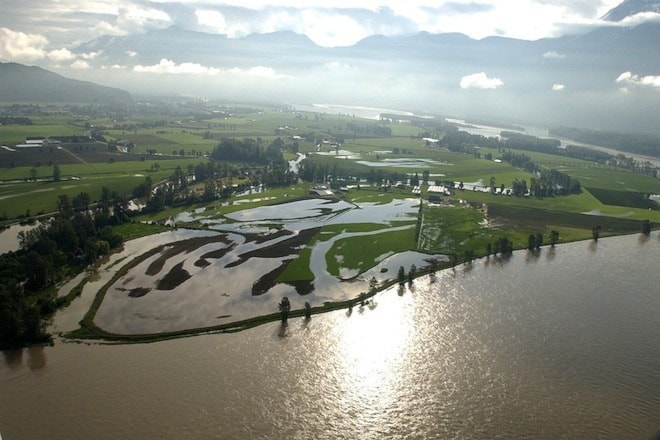Extreme flooding of the Lower Mainland would utterly devastate communities like Chilliwack, and area First Nations.
That's the word from a study by Fraser Basin Council, released this week as part of the Lower Mainland Flood Management Strategy (LMFMS).
City councillor Jason Lum said Chilliwack is right now about halfway through its dike upgrading program.
"We still have $28 to $30 million for the work left to be completed," Lum said.
Chilliwack's diking system needs to be elevated to the latest flood protection standards along with seismic upgrading.
"The next phases of the work should benefit from the Phase 2 funding," he said.
Coun. Lum was in attendance at the Hyatt Regency Monday, in his role as chair of the Flood Control & River Management Committee.
Attendees heard about the $1-million Phase 2 funding announcement from the province, and the flood study findings indicating that substantially more dike upgrading is necessary.
“All Lower Mainland municipalities are working hard on local flood protection priorities, and we’ll all do our part to keep communities safe from a catastrophic flood," said Lum.
The study findings show there's growing risk of a large-magnitude flood in the next 85 years that could cost in the billions. A major Fraser River flood today would result in total losses of $22.9 billion, the report estimated, and that could hit $32.7 billion by 2100.
A regional approach for planning and flood prevention was much needed, Lum said. The strategy has so far brought together 43 funding partners, from various levels of government to hammer out a new strategy.
The study showed that most municipalities have some level of vulnerability to extreme flooding, and disruptions would be widespread. First Nations communities were also deemed vulnerable to flooding, with two-thirds of reserves at risk, affecting 26 First Nations.
Tribal Chief Tyrone McNeil, vice-president of Sto:lo Tribal Council said Sto:lo communities are "more vulnerable" than anybody else since most don't have any dike protection whatsoever.
As a result of being surrounded by cities and municipalities, some First Nations are "the weak spot" in diking systems run by local governments.
"We recognize the importance of pre-emptive planning to be as prepared as we can for a major catastrophe, rather than responding last minute," he said.
"The piece that's been missing in all these discussions has been us. So we appreciate that the door has been opened to us in this way."
He was asked to speak at the Hyatt meeting on behalf of First Nations, but McNeil said he started by explaining he didn't have a specific mandate to do that.
But he acknowledged that First Nations will have a key role to play, by virtue of the landmark Chilcotin court decision, which grants First Nations inherent title to their land, as well as UN Declaration on the Rights of Indigenous People.
"We will need to be deeply involved at all levels in the planning, development and implementation of a comprehensive river management regime," said McNeil.
Next step is digesting all the latest study findings to see how it pertains to each of the local First Nation communities in Sto:lo territory. They'll be looking at flood scenarios, bank and asset protection, as well as impacts on salmon, agriculture and infrastructure, and look forward to meaningful participation in these processes in the future.
"I appreciated the fact the door has opened here for First Nations, by inviting us to speak. That's a good start," said McNeil.
